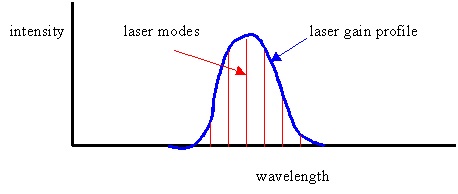


 علم الكيمياء
علم الكيمياء 
 الكيمياء التحليلية
الكيمياء التحليلية 
 الكيمياء الحياتية
الكيمياء الحياتية 
 الكيمياء العضوية
الكيمياء العضوية 
 الكيمياء الفيزيائية
الكيمياء الفيزيائية
 الكيمياء اللاعضوية
الكيمياء اللاعضوية 
 مواضيع اخرى في الكيمياء
مواضيع اخرى في الكيمياء
 الكيمياء الصناعية
الكيمياء الصناعية |
Read More
Date: 3-3-2020
Date: 18-2-2020
Date: 28-2-2020
|
Laser components
All lasers have three primary components:
The laser medium can be gaseous, liquid, or a solid. These could include atoms, molecules, or collections of atoms that would be involved in a laser transition. Typically, a laser is distinguished by its medium, even though two lasers using different media may have more in common than two which have similar media.
There are three different laser pumps: electromagnetic, optical, and chemical. Most lasers are pumped electro-magnetically, meaning via collisions with either electrons or ions. Dye lasers and many solid state lasers are pumped optically; however, solid state lasers are typically pumped with a broad band (range of wavelengths) flash-lamp type light source, or with a narrow band semiconductor laser. Chemically pumped lasers, using chemical reactions as an energy source, are not very efficient. So far, these lasers have been made to work not so much for their usefulness as for their curious operation.
Up to now in our discussion of laser theory we have not really seen how the beam is generated. We know that photons emitted by stimulated emission travel coherently in the same direction, but what is it that defines the beam direction and what allows the intensity of the laser light to get large? The answer to these two questions is coupled together in the resonant cavity. Laser resonant cavities usually have two flat or concave mirrors, one on either end, that reflect lasing photons back and forth so that stimulated emission continues to build up more and more laser light. The "back" mirror is made as close to 100% reflective as possible, while the "front" mirror typically is made only 95 - 99% reflective so that the rest of the light is transmitted by this mirror and leaks out to make up the actual laser beam outside the laser device.
The resonant cavity thus accounts for the directionality of the beam since only those photons that bounce back and forth between the mirrors lead to amplification of the stimulated emission. Once the beam escapes through the front mirror it continues as a well-directed laser beam. However, as the beam exits the laser it undergoes diffraction and does have some degree of spreading. Typically this beam divergence is as small as 0.05o but even this small amount will be apparent if the beam travels long distances.
Even more, the resonant cavity also accounts for the amplification of the light since the path through the laser medium is elongated by repeated passes back and forth. Typically this amplification grows exponentially, similar to the way compound interest works in a bank. The more money in your bank account, with compound interest, the faster you earn more interest dollars. Similarly, the more photons there are to produce stimulated emission, the larger the rate at which new coherent photons are produced. The term used for laser light is gain, or the number of additional photons produced per unit path length.
The last question to address in this section is: why is the resonant cavity called by that name? What does resonance have to do with having mirrors on either end of a region containing the laser medium? Recall that when we discussed resonance on a string, we spoke about the wave traveling one way along the string (say to the right) interfering with the wave reflected at the end traveling back to the left. At a resonant frequency, there are points at which the two waves exactly add or cancel all the time, leading to a standing wave. At other frequencies the waves will randomly add or cancel and the wave will not have a large amplitude. The case of a light wave traveling back and forth in the resonant cavity is exactly analogous in that only at certain resonant frequencies will the light wave be amplified. The required condition is easy to see. The mirror separation distance, L, must be equal to a multiple of half a wavelength of light, just as we saw in the case of a string. In symbols, we have that L = nl/2, where l is the wavelength of the light and n is some integer. In the case of light, because of the small wavelength n is a very large number, implying that there are a huge number of resonant frequencies. On the other hand, only those resonant frequencies that are amplified by the laser medium will have large amplitudes and so usually there are only a few so-called laser modes or laser resonant frequencies present in the light from a laser, as shown in the figure.




|
|
|
|
دراسة يابانية لتقليل مخاطر أمراض المواليد منخفضي الوزن
|
|
|
|
|
|
|
اكتشاف أكبر مرجان في العالم قبالة سواحل جزر سليمان
|
|
|
|
|
|
|
اتحاد كليات الطب الملكية البريطانية يشيد بالمستوى العلمي لطلبة جامعة العميد وبيئتها التعليمية
|
|
|